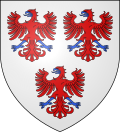History
The family originated from the county of Ponthieu. The oldest known member is Jean I of Brimeau, in whose memory his son, Jean II, knight, built a chapel in 1151.
Five members of the House of Brimeu were Knights of the Golden Fleece. Amongst the lands owned we find Humbercourt, Chaulnes, Poederlee, Ligny, Meghen and Wesemael. Charles of Brimeu sold Wesemael to Gaspar Schetz, and it became the property to the house of Ursel.
The last generations of the House of Brimeu, intermarried with important Flemish noble families like the houses of Glymes, Croy, Ursel, Schetz, Van de Werve, Snoy and Tucher von Simmelsdorf.
This page is based on this
Wikipedia article Text is available under the
CC BY-SA 4.0 license; additional terms may apply.
Images, videos and audio are available under their respective licenses.


